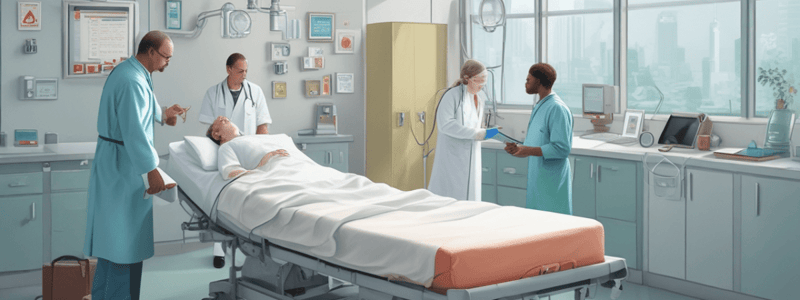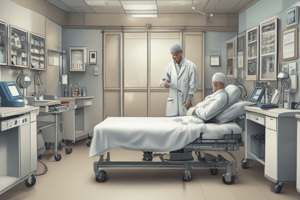Podcast
Questions and Answers
What is a major concern regarding the use of the term 'second victim'?
What is a major concern regarding the use of the term 'second victim'?
- It is not widely used in healthcare organizations
- It is not recognized by regulatory bodies
- It is only applicable to medical doctors
- It minimizes the harm experienced by the patient (correct)
According to a nationwide survey, what percentage of pharmacists reported being involved in a medication error?
According to a nationwide survey, what percentage of pharmacists reported being involved in a medication error?
- 75%
- 95.5% (correct)
- 100%
- 50%
How do healthcare organizations often react to an error involving a health professional?
How do healthcare organizations often react to an error involving a health professional?
- They are often in conflict about how to act (correct)
- They consistently provide guidance on what to do
- They always blame the individual
- They always support the individual
What is a common reaction of patients who experience an error?
What is a common reaction of patients who experience an error?
What is a concern about the term 'second victim' in relation to healthcare professionals?
What is a concern about the term 'second victim' in relation to healthcare professionals?
What is a key issue surrounding the term 'second victim' in healthcare?
What is a key issue surrounding the term 'second victim' in healthcare?
What percentage of respondents felt that healthcare organizations offered inadequate support for coping with stress?
What percentage of respondents felt that healthcare organizations offered inadequate support for coping with stress?
What is the reason many health professionals harmed by involvement in a medical error are never involved in disclosure?
What is the reason many health professionals harmed by involvement in a medical error are never involved in disclosure?
What is the result of full disclosure on patients considering filing a lawsuit?
What is the result of full disclosure on patients considering filing a lawsuit?
What is involved in the full disclosure process?
What is involved in the full disclosure process?
What is the benefit of formal training in error disclosure?
What is the benefit of formal training in error disclosure?
What is the reason clinicians may be hesitant to disclose errors?
What is the reason clinicians may be hesitant to disclose errors?
What is the result of non-disclosure in the example scenario?
What is the result of non-disclosure in the example scenario?
What is the important consideration in full disclosure regarding malpractice lawsuits?
What is the important consideration in full disclosure regarding malpractice lawsuits?
How many states in the U.S. have specific laws regarding error disclosure?
How many states in the U.S. have specific laws regarding error disclosure?
What is the importance of handling the error disclosure process thoughtfully and sensitively?
What is the importance of handling the error disclosure process thoughtfully and sensitively?
What is the primary distinction between human error and negligence in the context of healthcare?
What is the primary distinction between human error and negligence in the context of healthcare?
According to the Just Culture approach, how should management respond to an individual who exhibits at-risk behavior?
According to the Just Culture approach, how should management respond to an individual who exhibits at-risk behavior?
What is the primary goal of a blame-free safety culture in healthcare?
What is the primary goal of a blame-free safety culture in healthcare?
What is the likely outcome of a blame culture in healthcare?
What is the likely outcome of a blame culture in healthcare?
What is the impact of medical errors on healthcare providers, according to research?
What is the impact of medical errors on healthcare providers, according to research?
What is a potential predictor of the emotional impact of a medical error on a healthcare provider?
What is a potential predictor of the emotional impact of a medical error on a healthcare provider?
What is the primary distinction between a blame-free culture and a just culture in healthcare?
What is the primary distinction between a blame-free culture and a just culture in healthcare?
What is the impact of a medical error on a healthcare provider's quality of life, according to research?
What is the impact of a medical error on a healthcare provider's quality of life, according to research?
According to the Just Culture approach, what is the appropriate response to reckless behavior in healthcare?
According to the Just Culture approach, what is the appropriate response to reckless behavior in healthcare?
What is the primary goal of a just culture in healthcare?
What is the primary goal of a just culture in healthcare?
What warning is found on the top of the vecuronium medication vial?
What warning is found on the top of the vecuronium medication vial?
What was the consequence of RaDonda Vaught's error?
What was the consequence of RaDonda Vaught's error?
Why did RaDonda Vaught override the medication cabinet safety features?
Why did RaDonda Vaught override the medication cabinet safety features?
What was the outcome of the medical hearing for RaDonda Vaught?
What was the outcome of the medical hearing for RaDonda Vaught?
What was the consequence of Eric Cropp's error?
What was the consequence of Eric Cropp's error?
What was the reason for the delay in preparing the chemotherapy solution for Emily Jerry?
What was the reason for the delay in preparing the chemotherapy solution for Emily Jerry?
What assumption did Eric Cropp make during the check of the chemotherapy solution?
What assumption did Eric Cropp make during the check of the chemotherapy solution?
What was the consequence of Eric Cropp's error for the pharmacy technician?
What was the consequence of Eric Cropp's error for the pharmacy technician?
What was the outcome of the Ohio Board of Pharmacy's investigation into Eric Cropp's error?
What was the outcome of the Ohio Board of Pharmacy's investigation into Eric Cropp's error?
What was the criminal charge brought against Eric Cropp?
What was the criminal charge brought against Eric Cropp?
What was the sentence given to Eric Cropp for involuntary manslaughter?
What was the sentence given to Eric Cropp for involuntary manslaughter?
What is a major obstacle to error disclosure in healthcare?
What is a major obstacle to error disclosure in healthcare?
What is a benefit of shifting to a just culture in healthcare?
What is a benefit of shifting to a just culture in healthcare?
What are the negative effects of medical errors on healthcare professionals?
What are the negative effects of medical errors on healthcare professionals?
What is a key point about medical errors in healthcare?
What is a key point about medical errors in healthcare?
What do patients want from healthcare professionals after an error occurs?
What do patients want from healthcare professionals after an error occurs?
What is the primary goal of 'apology laws' in the context of medical malpractice?
What is the primary goal of 'apology laws' in the context of medical malpractice?
What is the primary benefit of Morbidity and Mortality (M&M) conferences?
What is the primary benefit of Morbidity and Mortality (M&M) conferences?
What is the main purpose of 'confessor' programs in institutions?
What is the main purpose of 'confessor' programs in institutions?
Why did RaDonda Vaught accidentally inject vecuronium into Charlene Murphey?
Why did RaDonda Vaught accidentally inject vecuronium into Charlene Murphey?
What is the primary reason why formal support programs for clinicians involved in medical errors are lacking?
What is the primary reason why formal support programs for clinicians involved in medical errors are lacking?
What is the recommended approach to medical error training in medical education?
What is the recommended approach to medical error training in medical education?
What is the primary benefit of implementing 'apology laws' in medical malpractice cases?
What is the primary benefit of implementing 'apology laws' in medical malpractice cases?
What is the main difference between 'admissions of fault' and 'expressions of sympathy' in medical malpractice cases?
What is the main difference between 'admissions of fault' and 'expressions of sympathy' in medical malpractice cases?
What is the primary goal of institutional support programs for clinicians involved in medical errors?
What is the primary goal of institutional support programs for clinicians involved in medical errors?
What is the recommended approach to conducting morbidity and mortality reviews?
What is the recommended approach to conducting morbidity and mortality reviews?
Study Notes
The Concept of Second Victim
- The term "second victim" refers to healthcare professionals who are involved in a medical error
- Critics argue that the term "second victim" minimizes the harm experienced by the patient and suggests that the error was unavoidable
- Healthcare professionals are highly likely to be involved in an error during their career, with 95.5% of pharmacists reporting being involved in a medication error
- Healthcare organizations are often conflicted about how to handle a healthcare professional involved in an error
Patient Reactions to Error
- Patients react and cope in different ways to achieve resolution after an error, including:
- Confronting the healthcare professional(s)
- Filing a lawsuit
- Going to the media with their experience
Key Takeaways
- Medical errors are an unavoidable part of healthcare
- Healthcare professionals also experience negative effects from errors, including depression, burnout, and decreased quality of life
- A "just culture" approach promotes error disclosure, learning from errors, and improving safety within an organization
- Patients want full disclosure from healthcare professionals, but this is often made difficult by legal and training barriers
Differentiating Error from Negligence
- Human error: an individual should have acted differently, resulting in an undesirable outcome
- Negligence: failure to exercise the skill, care, and learning expected of a reasonably prudent healthcare provider
Organizational Safety Culture
- Three types of safety cultures:
- Blame culture: discourages disclosure and reporting, promotes a culture of blame
- Blame-free culture: promotes disclosure and reporting, but lacks transparent investigation of error causes
- Just culture: promotes disclosure and reporting, supports system improvement, and balances accountability with learning from errors
Impact of Medical Errors on Providers
- Medical errors can have a significant emotional impact on healthcare professionals, including:
- Depression
- Burnout
- Decreased quality of life
- Feelings of distress, guilt, and shame
What Healthcare Professionals Should Do When Involved in an Error
- With the patient:
- Do not avoid the patient
- Disclose the error and apologize if appropriate
- Avoid defensive medical practice
- For themselves:
- Recognize that needing support after an error is normal
- Consider supportive discussion with colleagues and family members
- Pursue additional training to better understand and correct mistakes
Error Disclosure
- Full disclosure involves:
- Disclosure of all harmful errors
- Explanation of why the error occurred
- How the error's effects will be minimized
- Steps to prevent recurrences
- Acknowledgement of responsibility and apology
- The benefits of error disclosure include:
- Patients are less likely to consider filing a lawsuit
- Improved patient-provider relationships
- Opportunities for learning and improvement
Studying That Suits You
Use AI to generate personalized quizzes and flashcards to suit your learning preferences.
Description
This quiz explores the concept of 'second victim' in healthcare, referring to the emotional impact of medical errors on healthcare professionals. It discusses the concerns and criticisms surrounding the term, including its potential to minimize patient harm and undermine accountability. Test your understanding of this important topic in patient safety.




